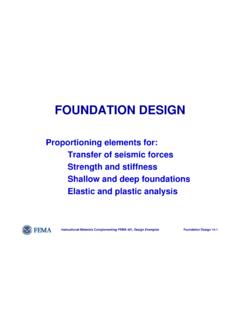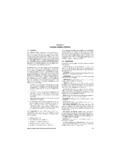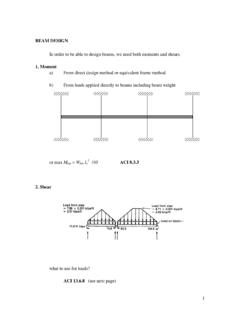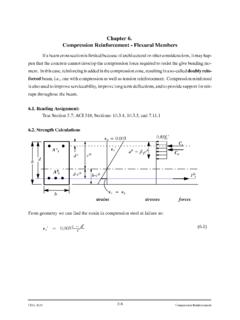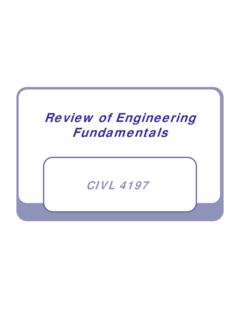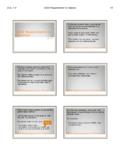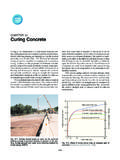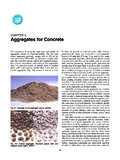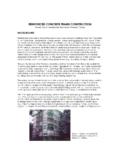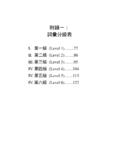Transcription of Topic 14 - Foundation Design - University of Memphis
1 Foundation Design . Proportioning elements for: Transfer of seismic forces Strength and stiffness Shallow and deep foundations Elastic and plastic analysis Instructional Materials Complementing FEMA 451, Design Examples Foundation Design 14-1. The subtitles are effectively a table of contents although the topics are not really treated in that specific order. This unit is primarily aimed at the structural engineering of foundations , not at the geotechnical engineering. This presentation relates to example computations Chapter 4 in the FEMA. 451, NEHRP Recommended Provisions: Design Examples. FEMA 451B Topic 14 Notes Foundation Design 14 - 1.
2 Load Path and Transfer to Soil Soil Pressure Pile supporting structure Force on a pile EQ on unloaded pile Inertial force deflected soil deflected soil deflected soil shape pressure shape pressure shape pressure Unmoving soil EQ Motion Instructional Materials Complementing FEMA 451, Design Examples Foundation Design 14-2. First model: soil pressures in unmoving soil caused by force at top of deep pile; most of stress resisted at top of pile; only small stresses below about twice the characteristic length of pile. Second model: unloaded pile subject to earthquake ground motion; small stresses induced by upper levels of soil lagging behind deep motion.
3 Note opposing directions of push.. Third model: both types of force act on pile. The lag of structure induces inertial forces at top of pile similar to static force in first model; net force shape similar to static situation. FEMA 451B Topic 14 Notes Foundation Design 14 - 2. Load Path and Transfer to Soil Soil-to- Foundation Force Transfer Passive earth Shallow pressure Friction EQ motion Instructional Materials Complementing FEMA 451, Design Examples Foundation Design 14-3. As building lags behind ground motion, induced inertial forces must be transferred between footing and soil. Design may consider that inertial forces are transferred as passive earth pressure on face of footing, friction on bottom of footing, or both.
4 FEMA 451B Topic 14 Notes Foundation Design 14 - 3. Load Path and Transfer to Soil Soil-to- Foundation Force Transfer Deep Soil Bending Motion pressure moment EQ Motion Instructional Materials Complementing FEMA 451, Design Examples Foundation Design 14-4. Same single story structure but now on deep pile Foundation . One leg shows pile displacements; the other shows resulting earth pressures; the third diagram shows bending moment in pile. One reference that has long been used for laterally loaded piles is the Navy Design Manual , foundations and Earth Structures. However, it and most other older methods are based upon assumptions of linear behavior in soil.
5 Over the past two decades considerable progress has been made in developing Design tools rooted in the strongly nonlinear behavior of soil. LPLILE is one widely used example that allows the user to specify soil parameters that model resistance of soil to lateral movement of piles. FEMA 451B Topic 14 Notes Foundation Design 14 - 4. Load Path and Transfer to Soil Vertical Pressures - Shallow Overturning moment EQ motion Instructional Materials Complementing FEMA 451, Design Examples Foundation Design 14-5. As aspect ratio of building height to width increases, overturning moment becomes significant; induced vertical forces must be transferred in addition to horizontal pressures.
6 (Similar vertical forces in footing result from column moments not specifically related to overturning.) Slide shows overturning moment being resisted below basement of medium sized building; horizontal pressures are transferred at the basement walls. FEMA 451B Topic 14 Notes Foundation Design 14 - 5. Load Path and Transfer to Soil Vertical Pressures - Deep Overturning moment EQ Motion Instructional Materials Complementing FEMA 451, Design Examples Foundation Design 14-6. This example of tall building with shear wall continuing through deep basement shows that the horizontal and vertical forces can be resisted by different portions of Foundation structure.
7 Basement wall resists horizontal forces near ground surface; vertical forces resisted by piles at base of wall. FEMA 451B Topic 14 Notes Foundation Design 14 - 6. Outside face of concrete column or line midway between face of steel column and edge of Reinforced Concrete steel base plate (typical). Footings: Basic Design (a). Critical section Criteria (concentrically for flexure loaded) extent of footing (typical). (b). Critical section d for one-way shear (c). Critical section for two-way shear d/2. (all sides). Instructional Materials Complementing FEMA 451, Design Examples Foundation Design 14-7. Reinforced concrete footings are proportioned according the the provisions of ACI 318, Building Code Requirements for Structural Concrete.
8 It is often opined that foundations should not yield due to the high cost of Foundation repair. However, nonlinear soil behavior is common in strong ground shaking, and it is traditional to Design foundations for the reduced forces computed with the response modification factor, R, used for the superstructure. Neither the NEHRP Recommended Provisions nor earlier model building codes required the use of amplified forces for Foundation Design . FEMA 451B Topic 14 Notes Foundation Design 14 - 7. P. M. (a). Loading (b). Footing Subject to Elastic, no uplift Compression and (c). Moment: Uplift Elastic, at uplift Nonlinear (d).
9 Elastic, after uplift (e). Some plastification (f). Plastic limit Instructional Materials Complementing FEMA 451, Design Examples Foundation Design 14-8. FEMA 356 has a good discussion of the plastic behavior of soil beneath eccentrically loaded footings. Just as for analysis of structural members, plastic analysis of a footing is simple by hand but not so with a computer. Both uplift and nonlinear behavior introduce complications in conventional analysis. Many commercially available software packages for structural analysis now handle the uplift case; a smaller set can also handle nonlinear behavior.
10 FEMA 451B Topic 14 Notes Foundation Design 14 - 8. 7 Bays @ 25'-0" = 175'-0". Example 1'-2" 1'-2". 7-story 5 Bays @ 25'-0" = 125'-0". Building: Shallow foundations designed for N perimeter 1'-2". frame and core bracing. Instructional Materials Complementing FEMA 451, Design Examples Foundation Design 14-9. FEMA 451B Topic 14 Notes Foundation Design 14 - 9. Shallow Footing Examples Soil parameters: Gravity load allowables Medium dense sand 4000 psf, B < 20 ft (SPT) N = 20 2000 psf, B > 40 ft Density = 120 pcf Bearing capacity (EQ). Friction angle = 33o 2000B concentric sq. 3000B eccentric = Instructional Materials Complementing FEMA 451, Design Examples Foundation Design 14-10.
